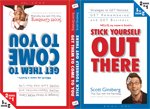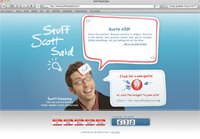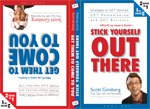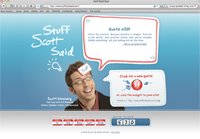 I contribute regular columns for a few dozen print and online publications.
I contribute regular columns for a few dozen print and online publications.
Last year, one particular article must have struck a nerve: I received over two thousand reader emails within 48 hours of its publication.
Awesome!
Unfortunately, my writer buzz was severally harshed when my editor forwarded me an email from an upset reader:
“Scott, this letter came for you from an English professor at Princeton. Apparently, he didn’t care for – or approve of – your writing style. Please see the attached three-page critique of your article.”
Imagine that was you. What would you do with that email?
TWO WORDS: De-lete.
LESSON LEARNED: Feedback is enormously profitable, but only when it comes from people who matter.
Otherwise, feedback nothing but procrastination in disguise. Just another confusing, unnecessarily discouraging, self-doubt-producing, undue-stress causing waste of time and tears.
HERE’S MY SUGGESTION: Don’t torture yourself over feedback from someone whose opinion doesn’t count. Execution is the byproduct of listening to the right people while ignoring the wrong people. It’s about self-trust and healthy impatience.
Today I’m going to help you create your own personal feedback filter to make sure you discern helpful advice from harmful absurdities.
1. Decide who’s worth ignoring. Let’s begin with a quick exercise to get you in the right headspace. Start a blank document. Title it, “Don’t listen to people who…” Then, list twenty answers to this question.
First of all, it’s easier than you think.
Secondly, it’s more fun when done with a partner.
Third, it’s most profitable when shared with a group.
By making this list, you’ll learn that self-confidence is learning who to listen to; whereas arrogance is assuming you don’t need to listen to anybody. Have you decided whom to ignore?
2. Love the haters. Nietzsche once remarked, “And those who were seen dancing were thought to be insane by those who couldn’t hear the music.” Next time people give you shit for being crazy, dust ‘em off. Don’t let the bastards grind you down. Especially if they’re the type of people whose imagination can’t encompass what it is that you want to do.
Instead, be grateful for their challenge to your commitment to craziness. Understand that they can’t hear the music you hear, nor will they ever hear the music you hear. Be okay with that. Maintain this attitude throughout the feedback process, and you’ll make it out alive. How will you use the haters to fuel your fire of insanity?
3. Excavate the gold. Todd Henry, founder of Accidental Creative, is an arms dealer for the creative revolution. In his awesome blog post, On Feedback, he wrote:
“One of the disciplines we need to learn is extracting truth from emotion. There is a tremendous amount of fear, apprehension and ego-protection that weaves its way into the feedback process; we need to learn to listen beyond the words that are being spoken. In turn, we can be tempted to react strongly in opposition to what we hear. But the truth lies somewhere in the middle.”
For example, I’ve received my share of hatemail over the years – all for wearing a damn nametag everyday. Interestingly, however, most of the hatemail messages I’ve received were sent anonymously. Huh. I guess it’s easy to hate from a distance.
Anyway, occasionally a piece of hatemail contains truth. Like the email I received the week after my website went live in 2002 from a visitor who said, “Scott, I clicked on the ‘Funny Stores’ page of your website, and, those stories aren’t funny.” Good tip. I quickly changed the menu item to just “Stories,” and got on with my life. Thanks for the feedback! How will you find (and use) the gold within the grime?
4. Practice self-questioning. Starting an internal dialogue with yourself is essential for leveraging the feedback that matters.
First, try these questions: Do I trust and value this person’s opinion of my performance? What might be the motivations behind this person giving me feedback? Do I seek feedback to get better or get approval?
Secondly, filter the feedback by testing it against your values: “Which one of these pieces of feedback most honors my values?”
Finally, consider this line of questions from Accidental Creative:
(a) What about this feedback do I like? What do I dislike? Why?
(b) Is the person offering the feedback (whether good or bad) protecting something? What is it? How is it affecting their feedback?
(c) What am I reacting against or rationalizing in an unhealthy way because I’m protecting something?
(d) Does this person have a track record of offering me honest positive and constructive criticism?
(e) What is actionable about their feedback? Is it anything that I can change right now and improve my work?
5. Unsolicited negative feedback is (usually) a manifestation of insecurity. Especially when someone prefaces her supposedly brilliant wisdom with, “Let me give a friendly piece of advice…” Wrong. It’s rarely friendly and it’s not advice – it’s projection in disguise. There’s a fine line between helpful, gentle criticism and vindictive self-projection.
The question you have to ask yourself is, “Does this person offer feedback from the desire to see me become better or from a desire to see me fail?” Hopefully the former; because as we’ve all experienced at some time or another, there are some people out there who simply don’t want to see you succeed. Jerks. Are you willing to tune out people who don’t have you best interests at heart?
6. Strike a healthy balance. Feedback-free environments are not conducive to learning new skills. But feedback bloated environments are not conducive to executing old skills. Your challenge is discernment. As Alan Weiss explained in Thrive:
“In major decisions, involve others. Whether personally or professionally, avail yourself of the intelligence and experience of others. Conversely, never accept unsolicited feedback. It is always given for the benefit of the sender, and it will cause you to be bounced around as if you were in a pinball machine. Act only on patterns, not random events. Once is an accident, twice a coincidence, three times a pattern. Whether positive or negative, don’t bounce around in the feedback pinball machine.”
Ultimately, it’s like playing in a rock band. Feedback can make your performance better, louder and stronger – but too much of it can also blow your amp and ruin the show for everybody. Are you a master of discernment?
7. More feedback doesn’t always equal better performance. I recently hosted an entrepreneur workshop Florida. During the first module, I instructed the group to write down three questions they asked themselves every day. Next, when we scattered the index cards across the floor, one question in particular caught my attention: “What if my boss is right about me?”
Silence fell across the room. And the young woman to my left, Karen, sheepishly said, “Um, that was mine.” Turns out she worked for a company that, until recently, she loved. But when her new manager took the reins, everything changed. “This bully of a boss gives me non-stop feedback – most of which is negative and nit-picky,” Karen said. “And that does nothing but cause me stress and make me second guess my performance.”
Lesson learned: Micro-managing insecure employees with too much feedback has an adverse effect on job performance. If you find yourself in a situation like Karen’s, speak up early. Otherwise you might convince yourself that your boss is right about you – even if she’s not. What one person in your life gives you too much feedback?
8. Learn to trust your voice. When I started my career as a speaker, I used to collect evaluations at the end of my presentations. The problem was, I’d receive two hundred glowing reviews, and one crappy critique.
Which one would you focus on?
Of course. The negative one. Because they always weigh on your heart the heaviest. To the point of obsessive compulsiveness. Meanwhile, all your positive feedback becomes overshadowed.
Lesson learned: Resist the pull of negative feedback. It drags you away from positive. Trash the evaluations. Learn to trust your inner judge. Decide for yourself how well you did and let rest go. All those negative reviews will do is bring you down to an annoyed, depressed version of yourself.
This reminds me of a speech I gave in 2006 that received horrible evaluations across the board. Except for Jody. She loved the program. So much so that she booked me (four years later!) for a gig in South Korea where I spoke to three thousand people. Hmm. I guess bombing is relative. Maybe pleasing the people who pay is what matters. Are you immobilized by unsolicited opinions that don’t count?
9. Avoid the paralysis of prioritization. Dwelling incapacitates you. Especially when the feedback is negative. My suggestion: Stop spinning round and round in circles and over-complicating things, when, if you get right down to it, simply doesn’t count. Overanalyzing is a waste of time. Don’t let words from someone who doesn’t matter stress you out and make you second-guess yourself.
Looking for too much feedback may ultimately result in waste time and a failure to prioritize in a timely manner. Romance author Charlene Teglia said it best:
“In order to succeed as a writer (or really, in any area) you have to have a peculiar balance of confidence and humility. You have to know when you don’t know it all and be willing to learn from those who know more. But you also have to have the confidence to know who you shouldn’t listen to, because somebody can be right – and at the same time, dead wrong for you.”
Lesson learned: Feedback from the right people (and the ability to make subsequent changes) leads to enhanced performance. What paralyzes you?
In conclusion, we turn to singer Amy Grant, who sang a beautiful song called, “Who To Listen To.”
Don’t take a ride from a stranger.
No way to know where they go.
You may be left on a long dark road, lost and alone.
Don’t you recall what your Mama told?
You’ve got to learn hot from cold.
When you’re afraid that you might get burned,
Where do you turn?
You’ve got to know who to, who not to listen to.
Well, you know, they’re gonna hit you from all sides.
Better make up your mind who to, who not to listen to.
How can you learn what is true and just? How to know who to trust?
Here comes a man with a scam to sell. How can you tell?
You’ve gotta know there’s a bigger plan, room to fall, room to stand.
Pray for the plan to begin in you; keep your heart true.
Everyone will have their words to say.
Find the word to help you find your way.
ULTIMATELY: Ignoring feedback is hard.
It takes heaps of self-confidence, plenty of self-control and vast self-knowledge.
But it sure beats the alternative. Because demanding excessive reassurance is a one-way ticket to entrepreneurial purgatory.
I challenge you to stop exposing yourself to harsh, unsolicited feedback; and to start trusting your voice.
Start listening to the people who matter.
Even if they didn’t get an English degree from Princeton.
LET ME ASK YA THIS…
Do you really need more feedback?
LET ME SUGGEST THIS…
For the ebook called, “101 People (not) to Listen to,” go here.
* * * *
Scott Ginsberg
That Guy with the Nametag
Author, Speaker, Entrepreneur, Mentor
[email protected]
 The world’s FIRST two-in-one, flip-flop book!
The world’s FIRST two-in-one, flip-flop book!
Buy Scott’s comprehensive marketing guidebook on Amazon.com and learn how to GET noticed, GET remembered and GET business!N

 “Wow, you sure know how to make a point!”
“Wow, you sure know how to make a point!”
 Ever since I was a kid, being a disturbance has always been one of my favorite pastimes.
Ever since I was a kid, being a disturbance has always been one of my favorite pastimes.
 When I was in kindergarten, our class has a Tasting Party.
When I was in kindergarten, our class has a Tasting Party. Who’s quoting YOU?
Who’s quoting YOU? “What were you thinking when you decided to wear a nametag every day for the rest of your life?”
“What were you thinking when you decided to wear a nametag every day for the rest of your life?” The world’s FIRST two-in-one, flip-flop book!
The world’s FIRST two-in-one, flip-flop book! Pharmaceutical companies are well known for having an abundance of three things:
Pharmaceutical companies are well known for having an abundance of three things: Who’s quoting YOU?
Who’s quoting YOU? You know what you need to do.
You know what you need to do. I contribute regular columns for a few dozen print and online publications.
I contribute regular columns for a few dozen print and online publications.  The world’s FIRST two-in-one, flip-flop book!
The world’s FIRST two-in-one, flip-flop book! I started my company the week after I graduated college.
I started my company the week after I graduated college.